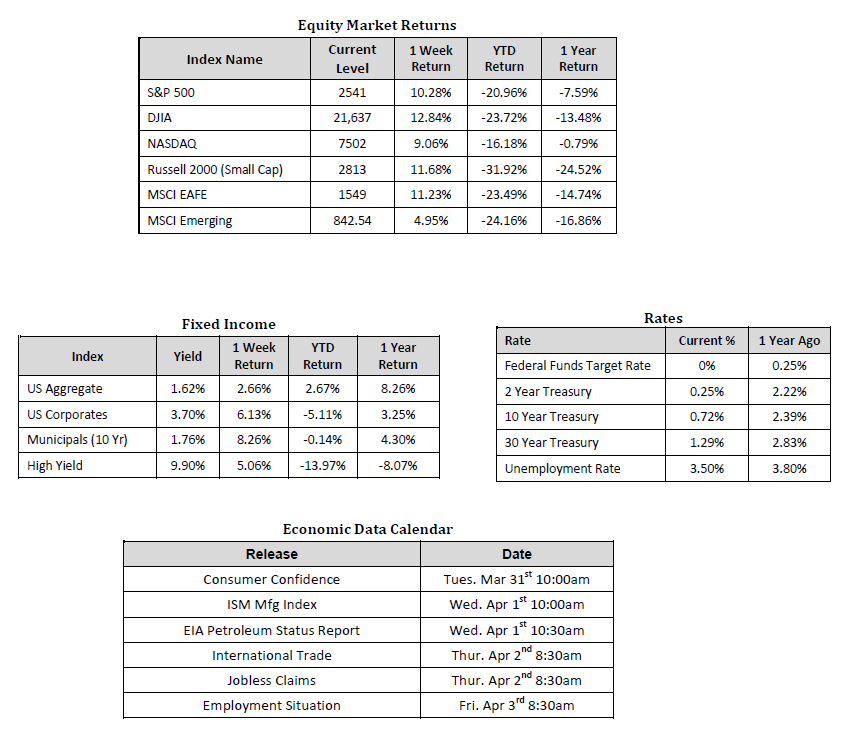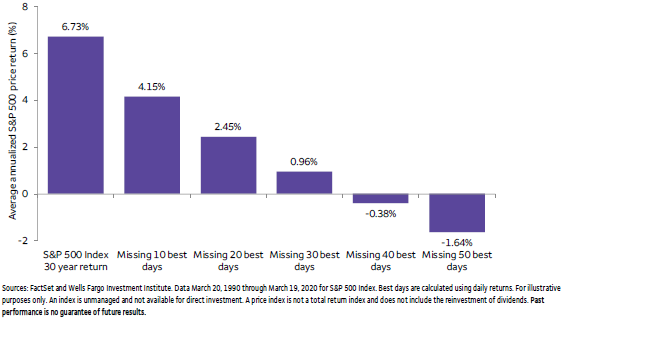
Should Stock Investors Attempt to Time the Stock Market Recovery?
Market Overview

Sources: Sources for data in tables: Equity Market and Fixed Income returns are from JP Morgan as of 03/27/2020. Rates and Economic Calendar Data from Bloomberg as of 03/27/2020. International developed markets measured by the MSCI EAFE Index, emerging markets measured by the MSCI EM Index. Sector performance is measured using GICS methodology.
Happening Now
What a wild ride global equity markets took last week as investors attempted to digest an overflow of information regarding steps taken by the Federal Reserve and the Federal Government to combat the economic fallout associated with COVID-19. While Monday and Friday marked down days for the S&P 500 Index last week, Tuesday through Thursday provided investors with a much welcomed and needed rally, thanks in large part to the ultimate passage of the CARES Act by the U.S. Congress.
In the U.S., the S&P 500 Index propelled to a level of 2,541, representing a gain of 10.28%, while the Russell Midcap Index increased 13.54% last week. Meanwhile, the Russell 2000 Index, a measure of the Nation’s smallest publicly traded firms, returned 11.68% over the week. Stellar performance wasn’t limited to just U.S. equities, as developed and emerging markets moved 11.23% and 4.95% higher, respectively. Finally, the yield on the 10-year U.S. Treasury fell to 0.72% from 0.92%, an adjustment that’s at least in part attributable to the Federal Reserve’s promise to purchase an unlimited amount of U.S. Treasuries if necessary.
In previous updates, we’ve outlined how incredibly difficult, if not impossible, it is to time a market crash and corresponding recovery accurately. Historically, equity markets have entered bear market territory, found a bottom, and begun to recover from that bottom in the span of only two weeks on average. More importantly, we know from previous market cycles that some of the best performing days a bull market has to offer often take place during these two weeks. For an example of this dynamic at play, one need not look further than the 10%+ return produced by the S&P 500 Index last week.
Missing out on as few as two of the most robust trading days that a bull market has to offer will have a material, though usually manageable, impact on an investor’s long-term average performance. However, missing out on ten of the best performing days, many of which are liable to occur early in the recovery, will place almost any investor in a hole that may be difficult to recover from. Consider the chart below, which highlights the average performance of an investor who presumably attempted to time the market and subsequently missed a handful of the market’s most fruitful days.

Unsurprisingly, the hypothetical investor, who unsuccessfully attempted to time the market, went on to trail the overall market by 2.58% per year over the last 30 years. That means over a 30-year time frame, an investor would miss out on nearly 80% in absolute return, not to mention forgoing years of potential compounded interest/dividends.
We, at SmartTrust®, are advocates for portfolio diversification rather than market timing. So, instead of attempting the herculean task of market timing, we suggest that investors take a moment to revisit the diversification that may, or may not, exist in their current portfolios. Have you been unbearably uncomfortable with, and overwhelmed by, the bout of volatility currently gripping markets? If the answer is yes, it might be time to take a hard look at the asset classes that comprise your portfolio, and the respective weighting assigned to each. As always, we encourage investors to stay disciplined and work with experienced financial professionals to help manage their portfolios through various market cycles within an appropriately diversified framework that is consistent with their objectives, time-frame, and tolerance for risk.
Best wishes for continued health and safety to all.
Important Information and Disclaimers
Disclosures: Past performance does not guarantee future results. We have taken this information from sources that we believe to be reliable and accurate. Hennion and Walsh cannot guarantee the accuracy of said information and cannot be held liable. You cannot invest directly in an index. Diversification can help mitigate the risk and volatility in your portfolio but does not ensure a profit or guarantee against loss. Hennion & Walsh is the sponsor of SmartTrust® Unit Investment Trusts (UITs). For more information on SmartTrust® UITs, please visit www.smarttrustuit.com. The overview above is for informational purposes and is not an offer to sell or a solicitation of an offer to buy any SmartTrust® UITs. Investors should consider the Trust’s investment objective, risks, charges and expenses carefully before investing. The prospectus contains this and other information relevant to an investment in the Trust and investors should read the prospectus carefully before they invest.
Investing in foreign securities presents certain risks not associated with domestic investments, such as currency fluctuation, political and economic instability, and different accounting standards. This may result in greater share price volatility. These risks are heightened in emerging markets.
There are special risks associated with an investment in real estate, including credit risk, interest rate fluctuations and the impact of varied economic conditions. Distributions from REIT investments are taxed at the owner’s tax bracket.
The prices of small company and mid cap stocks are generally more volatile than large company stocks. They often involve higher risks because smaller companies may lack the management expertise, financial resources, product diversification and competitive strengths to endure adverse economic conditions.
Investing in commodities is not suitable for all investors. Exposure to the commodities markets may subject an investment to greater share price volatility than an investment in traditional equity or debt securities. Investments in commodities may be affected by changes in overall market movements, commodity index volatility, changes in interest rates or factors affecting a particular industry or commodity.
Products that invest in commodities may employ more complex strategies which may expose investors to additional risks.
Investing in fixed income securities involves certain risks such as market risk if sold prior to maturity and credit risk especially if investing in high yield bonds, which have lower ratings and are subject to greater volatility. All fixed income investments may be worth less than original cost upon redemption or maturity. Bond Prices fluctuate inversely to changes in interest rates. Therefore, a general rise in interest rates can result in the decline of the value of your investment.
Definitions
MSCI- EAFE: The Morgan Stanley Capital International Europe, Australasia and Far East Index, a free float-adjusted market capitalization index that is designed to measure developed-market equity performance, excluding the United States and Canada.
MSCI-Emerging Markets: The Morgan Stanley Capital International Emerging Market Index, is a free float-adjusted market capitalization index that is designed to measure the performance of global emerging markets of about 25 emerging economies.
Russell 3000: The Russell 3000 measures the performance of the 3000 largest US companies based on total market capitalization and represents about 98% of the investible US Equity market.
ML BOFA US Corp Mstr [Merill Lynch US Corporate Master]: The Merrill Lynch Corporate Master Market Index is a statistical composite tracking the performance of the entire US corporate bond market over time.
ML Muni Master [Merill Lynch US Corporate Master]: The Merrill Lynch Municipal Bond Master Index is a broad measure of the municipal fixed income market.
Investors cannot directly purchase any index.
LIBOR, London Interbank Offered Rate, is the rate of interest at which banks offer to lend money to one another in the wholesale money markets in London.
The Dow Jones Industrial Average is an unweighted index of 30 “blue-chip” industrial U.S. stocks.
The S&P Midcap 400 Index is a capitalization-weighted index measuring the performance of the mid-range sector of the U.S. stock market, and represents approximately 7% of the total market value of U.S. equities. Companies in the Index fall between S&P 500 Index and the S&P SmallCap 600 Index in size: between $1-4 billion.
DJ Equity REIT Index represents all publicly traded real estate investment trusts in the Dow Jones U.S. stock universe classified as Equity REITs according to the S&P Dow Jones Indices REIT Industry Classification Hierarchy. These companies are REITs that primarily own and operate income-producing real estate.



